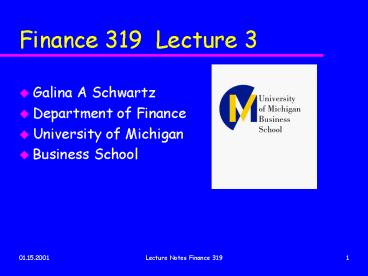Finance 319 Lecture 3 - PowerPoint PPT Presentation
Title:
Finance 319 Lecture 3
Description:
Overview of International Monetary System I. Readings: Levich, ... 6. & 7. The Spirit of EMU & the Current Rules, Box 2.6-7, pp. 38-9. Benefits of the union: ... – PowerPoint PPT presentation
Number of Views:35
Avg rating:3.0/5.0
Title: Finance 319 Lecture 3
1
Finance 319 Lecture 3
- Galina A Schwartz
- Department of Finance
- University of Michigan
- Business School
2
Practical Matters Office Hours Change
- My office D3270A (Davidson Hall)
- My e-mail galka_at_umich.edu
- My office hours
- Mon., 10am -12pm , Th., 1 pm -3 pm
- or by appointment
- Notice a change was Th., 3 pm - 5 pm
3
Overview of International Monetary System I
- Readings Levich, Chapter 2
- History (seven episodes, see Levich, boxes 2.1 -
2.7) - Current Trends
- to float from fixed
- to less capital controls
4
Overview of International Monetary System II
- Current rules of the game
- volatility ? (due to float) ? need to hedge
- Emerging markets currency board,
- issues credibility, commitment
- Europe common currency (EURO) will it last?
5
Rules of the Game a set of explicit and implicit
rules
- laws regulations
- customs conventions
- IFS as a factor of production (i.e. financial
infrastructure) - Government Objective is twofold
- 1. Domestic Agenda Gov-t Promises
- 2. International Agenda Gov-t Promises
- 1 2 are contradictory
6
1. The Gold Standard, 1879 - 1913, Box 2.1, p. 24
- I. - a definition
- II. - a rule used (no capital controls)
- III. - a result of I and II.
- VI. - the means to sustain the system.
- V. - the means to sustain the system
- VI. - a major system feature common price level.
7
2. Bretton Woods, Box 2.2, p. 27
- I. II. - a definition
- III. - free convertibility - a result of I.
- III. (capital controls) VI. - the means to
sustain the system achieve national
macroeconomic autonomy - V. - a major system feature macro autonomy
8
3. Fixed-Rate Dollar Standard, 1950 - 1970, Box
2.3, p. 29
- growing foreign reserves U.S. Balance of
Payment deficits - countries peg exchange rates to US within 1 of
par value - which is US Dollar is used as a gold
9
Why the rules of the game change?
- When does the change happen?
- How fast does it happen?
- Is it easy to change the rules?
- Could it possibly be an easy and fast process?
10
More Rules of the Game
- 4. Floating-Rate Dollar Standard, 1973 - 1984,
- Box 2.4, p. 33
- 5. Plaza-Louvre Accord Floating-Rate Dollar
Standard, 1985-1996, - Box 2.5, p. 35
11
6. 7. The Spirit of EMU the Current Rules,
Box 2.6-7, pp. 38-9
- Benefits of the union
- Exchange rate uncertainty is reduced
- Price transparency
- Political cooperation economic convergence.
- Costs of the union
- Loss of monetary independence
- Difficulty adjusting to external shocks.
12
An Example (US - Mexico)
- Does Trade Deficit matter?
- Reasons for Trade Deficit
- corporate --tax regulatory
- exchange rate dis-equilibrium
- dynamic production consumption adjustment
13
Next Lecture
- To read Levich, Chapter 3
- Millman, Gregory, 1995, The Vandals' Crown How
Rebel Currency Traders Overthrew the World's
Central Banks, Free Press. (further Millman) The
golden vanity, pp.65-94. (S)
14
Summary of Today
- Basic Concepts, See Lecture 2 notes
- Rules of the Game
- history of international monetary system
- features of the system its support mechanisms
- pluses and minuses of different rules of the game
- One central bank speculation































